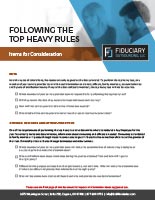
The Story
Marble Hill Mortgage Company was a small mortgage company that sponsored a 401(k) plan for its employees. Their service provider team required that they identify owners, family members of owners and officers through the payroll system. In 2009, they hired a new HR person, Jonathon, who did the data entry for the 2009 plan year in early 2010.
Jonathon was new to his job. He had never worked with a 401(k) plan before. So, he miscoded the owner and office information. For the first time ever, the plan failed its top heavy testing. Jonathon downloaded the report of who was owed the top heavy minimum contributions. Then he headed over to the VP of Finance’s office to ask for the roughly $300,000 of required top heavy minimum contributions that were due to the plan. The VP of Finance was NOT happy.
How did they fix it?
Marble Hill hired a consultant to review the testing. The outside consultant corrected the identification of who is an owner and who is an officer. The test was rerun and passed.
Since the test passed and no contributions were made that had to be returned, the error was fixed simply by placing a copy of the correct testing results in the plan’s records. Marble Hill’s costs amounted to the consultant who correctly identified owners and officers and amended the top heavy test. It was about a $5,000 project. But, it was much less than making a $300,000 top heavy minimum contribution to the plan.
How did they ensure it didn’t happen again?
Marble Hill’s CFO realized that Jonathon didn’t have the retirement plan expertise to understand how to properly code the payroll system. If the payroll system data was wrong, the test results would be wrong. After reviewing the options available to him, the CFO retained Fiduciary Outsourcing to oversee the plan’s payroll processing and nondiscrimination testing. These were the two services Fiduciary Outsourcing offered that he felt were most needed for his company’s plan.

The Mistake
The Internal Revenue Code contains a rule that basically says that if 60% or more of the money in the plan belongs to owners and highly paid officers, certain contributions must be made by the plan sponsor to all of the other eligible employees. Just to be clear, that is an incredibly brief summary of a considerable amount of regulation. Hopefully it’s enough for you to get a general idea though of the concept.
There are two types of errors here. In the first error, the test to determine if 60% or more of the money in the plan belongs to owners and highly paid officers, the “top heavy test”, is not performed. In the second error, the required contributions either aren’t made or aren’t properly made. These contributions are called “top heavy minimum contributions”. Most top heavy errors occur in small plans as larger plans tend not to be top heavy, i.e. owners and highly paid officers have less than 60% of the money in the plan.
Some plans use on-line self-service models to complete their testing. In order for these models to work, employee information about ownership and officer status and family relationships must be coded in the system. Determining who is an officer is based on job function, not job title. Ownership is as simple as direct ownership. There is also indirect ownership such as a husband is considered to own his wife’s stock and vice versa. Some systems go further and ask you to determine which employees will be considered “key employees”, a.k.a. the highly paid owners and officers for the purposes of this test. Still other service providers will ask for the information and rely on you to properly identify everyone. If the basic data is incorrect, the test will be incorrect.
In the event the top heavy test says the top heavy minimum contributions must be made, the law specifies how to calculate these contributions. Let’s say that the plan provides contributions based on gross compensation less bonuses. Well, the top heavy minimum contributions must be calculated on gross compensation. Yes, the law in this case overrides the plan provisions.
What if the plan says no one who works less than 1,000 hours in the year gets a top heavy minimum contribution? Well, the top heavy rules require contributions for all who are eligible for the plan and employed on the last day of the year. Again, the law overrides the plan provisions.
In the end, someone must perform the test correctly. And, if the test says the top heavy minimum contributions must be made, calculate those minimum contribution amounts correctly.

What Happens
In all probability, you won’t realize you made this mistake. It will get caught by the plan’s independent CPA auditor or an IRS or DOL agent. So, by the time the error is most likely to be identified, it will be some time after the period in which the test should have been run.
If the error is that you failed to ensure the top heavy test was run, have someone run the test now. If the test shows the plan was not top heavy, all is well. The plan is in exactly the same place it would have been if the test had been done timely. That being said, steps should be put in place to ensure the test is completed each year and proper documentation provided to you.
What if the test failed when you had it run? Or perhaps it was run but the data used was incorrect and the plan now fails the test? Well, participants are entitled to their top heavy minimum contributions adjusted with interest. Depending on how far back the error goes, you may be able to self-correct the error or you may be required to submit the plan to IRS using their voluntary correction program.
What if you had previously run the test and it failed, but now you determine it passed? Well, you would have made the top heavy minimum contributions when you thought the test failed. You’d have to look at the plan document to see if there is any way to get the funds back. If the plan provides for a discretionary profit sharing contribution or discretionary match, you would re-characterize the money as one of these two types of discretionary contributions. If the plan allowed for 401(k) deferrals only, and states that employer contributions will only be made in the event the plan is top heavy, you may be able to get the money back under the mistake in fact contribution language in the plan document. Do not return funds without talking to a consultant or ERISA attorney.
What if you failed to make the top heavy minimum contributions or made the wrong amounts? You need to put the money into the plan as soon as possible with an appropriate amount of interest for not doing this timely. If the mistake impacts only a few of your employees and / or is only applicable to the most recent two years, you can self-correct the mistake. Otherwise you may need to submit the plan to the IRS for approval to correct using the voluntary correction program.
Avoid it
The top heavy testing and top heavy required minimum contribution calculations are not something the average person will want to tackle. If you want to learn more about the top heavy rules, you can google for regulation 1.416-1. You should find a website that will take you to the full text of the regulation.
You’ll need to rely on your service provider team to complete the testing and, if necessary, calculate the required contributions. Your service provider team will rely on you to provide the necessary data. In addition, you may need to pull the results off of a self-service website portal. So, it’s critically important that you understand what your service provider team will do in this regard and what data they required.
First, you should meet with your service provider team to ensure you know who performs the testing and contribution calculations. Second, you should ask them about the data they’ll require to properly perform the work. Next, be sure that the information is accurately provided to them each year. If you must download your own testing results, be sure someone on your team is specifically assigned this role. Lastly, if contributions are required to be made, be sure they get made timely.

How We Help
You should be outsourcing the calculations of the top heavy testing and required minimum contributions. Determining owners and officers is something you cannot outsource. However, you can ask for an outside party to review your ownership and officer determinations or to review a test that you believe is in error. Fiduciary Outsourcing has the skills and training to assist you in these matters as a consultant.

Checklist
Download the items for consideration in following the top heavy rules.

The Story
Marble Hill Mortgage Company was a small mortgage company that sponsored a 401(k) plan for its employees. Their service provider team required that they identify owners, family members of owners and officers through the payroll system. In 2009, they hired a new HR person, Jonathon, who did the data entry for the 2009 plan year in early 2010.
Jonathon was new to his job. He had never worked with a 401(k) plan before. So, he miscoded the owner and office information. For the first time ever, the plan failed its top heavy testing. Jonathon downloaded the report of who was owed the top heavy minimum contributions. Then he headed over to the VP of Finance’s office to ask for the roughly $300,000 of required top heavy minimum contributions that were due to the plan. The VP of Finance was NOT happy.
How did they fix it?
Marble Hill hired a consultant to review the testing. The outside consultant corrected the identification of who is an owner and who is an officer. The test was rerun and passed.
Since the test passed and no contributions were made that had to be returned, the error was fixed simply by placing a copy of the correct testing results in the plan’s records. Marble Hill’s costs amounted to the consultant who correctly identified owners and officers and amended the top heavy test. It was about a $5,000 project. But, it was much less than making a $300,000 top heavy minimum contribution to the plan.
How did they ensure it didn’t happen again?
Marble Hill’s CFO realized that Jonathon didn’t have the retirement plan expertise to understand how to properly code the payroll system. If the payroll system data was wrong, the test results would be wrong. After reviewing the options available to him, the CFO retained Fiduciary Outsourcing to oversee the plan’s payroll processing and nondiscrimination testing. These were the two services Fiduciary Outsourcing offered that he felt were most needed for his company’s plan.

The Mistake
The Internal Revenue Code contains a rule that basically says that if 60% or more of the money in the plan belongs to owners and highly paid officers, certain contributions must be made by the plan sponsor to all of the other eligible employees. Just to be clear, that is an incredibly brief summary of a considerable amount of regulation. Hopefully it’s enough for you to get a general idea though of the concept.
There are two types of errors here. In the first error, the test to determine if 60% or more of the money in the plan belongs to owners and highly paid officers, the “top heavy test”, is not performed. In the second error, the required contributions either aren’t made or aren’t properly made. These contributions are called “top heavy minimum contributions”. Most top heavy errors occur in small plans as larger plans tend not to be top heavy, i.e. owners and highly paid officers have less than 60% of the money in the plan.
Some plans use on-line self-service models to complete their testing. In order for these models to work, employee information about ownership and officer status and family relationships must be coded in the system. Determining who is an officer is based on job function, not job title. Ownership is as simple as direct ownership. There is also indirect ownership such as a husband is considered to own his wife’s stock and vice versa. Some systems go further and ask you to determine which employees will be considered “key employees”, a.k.a. the highly paid owners and officers for the purposes of this test. Still other service providers will ask for the information and rely on you to properly identify everyone. If the basic data is incorrect, the test will be incorrect.
In the event the top heavy test says the top heavy minimum contributions must be made, the law specifies how to calculate these contributions. Let’s say that the plan provides contributions based on gross compensation less bonuses. Well, the top heavy minimum contributions must be calculated on gross compensation. Yes, the law in this case overrides the plan provisions.
What if the plan says no one who works less than 1,000 hours in the year gets a top heavy minimum contribution? Well, the top heavy rules require contributions for all who are eligible for the plan and employed on the last day of the year. Again, the law overrides the plan provisions.
In the end, someone must perform the test correctly. And, if the test says the top heavy minimum contributions must be made, calculate those minimum contribution amounts correctly.

What Happens
In all probability, you won’t realize you made this mistake. It will get caught by the plan’s independent CPA auditor or an IRS or DOL agent. So, by the time the error is most likely to be identified, it will be some time after the period in which the test should have been run.
If the error is that you failed to ensure the top heavy test was run, have someone run the test now. If the test shows the plan was not top heavy, all is well. The plan is in exactly the same place it would have been if the test had been done timely. That being said, steps should be put in place to ensure the test is completed each year and proper documentation provided to you.
What if the test failed when you had it run? Or perhaps it was run but the data used was incorrect and the plan now fails the test? Well, participants are entitled to their top heavy minimum contributions adjusted with interest. Depending on how far back the error goes, you may be able to self-correct the error or you may be required to submit the plan to IRS using their voluntary correction program.
What if you had previously run the test and it failed, but now you determine it passed? Well, you would have made the top heavy minimum contributions when you thought the test failed. You’d have to look at the plan document to see if there is any way to get the funds back. If the plan provides for a discretionary profit sharing contribution or discretionary match, you would re-characterize the money as one of these two types of discretionary contributions. If the plan allowed for 401(k) deferrals only, and states that employer contributions will only be made in the event the plan is top heavy, you may be able to get the money back under the mistake in fact contribution language in the plan document. Do not return funds without talking to a consultant or ERISA attorney.
What if you failed to make the top heavy minimum contributions or made the wrong amounts? You need to put the money into the plan as soon as possible with an appropriate amount of interest for not doing this timely. If the mistake impacts only a few of your employees and / or is only applicable to the most recent two years, you can self-correct the mistake. Otherwise you may need to submit the plan to the IRS for approval to correct using the voluntary correction program.
Avoid it
The top heavy testing and top heavy required minimum contribution calculations are not something the average person will want to tackle. If you want to learn more about the top heavy rules, you can google for regulation 1.416-1. You should find a website that will take you to the full text of the regulation.
You’ll need to rely on your service provider team to complete the testing and, if necessary, calculate the required contributions. Your service provider team will rely on you to provide the necessary data. In addition, you may need to pull the results off of a self-service website portal. So, it’s critically important that you understand what your service provider team will do in this regard and what data they required.
First, you should meet with your service provider team to ensure you know who performs the testing and contribution calculations. Second, you should ask them about the data they’ll require to properly perform the work. Next, be sure that the information is accurately provided to them each year. If you must download your own testing results, be sure someone on your team is specifically assigned this role. Lastly, if contributions are required to be made, be sure they get made timely.

How We Help
You should be outsourcing the calculations of the top heavy testing and required minimum contributions. Determining owners and officers is something you cannot outsource. However, you can ask for an outside party to review your ownership and officer determinations or to review a test that you believe is in error. Fiduciary Outsourcing has the skills and training to assist you in these matters as a consultant.

Checklist
Download the items for consideration in following the top heavy rules.

